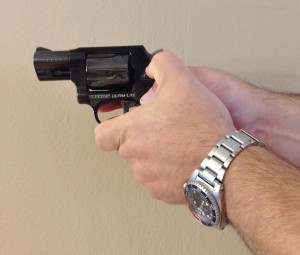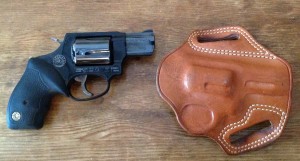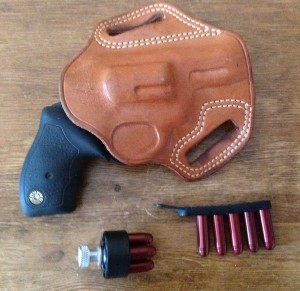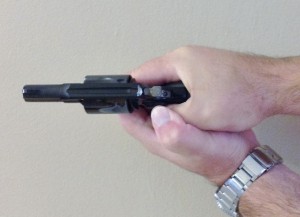IDPA BUG Match emphasizes need to focus on fundamentals.
Armed Citizen July 13th. 2012, 11:08pmA local sportsman club held an IDPA BUG (Back Up Gun) match this month and it served as a very useful training experience. The International Defensive Pistol Association (www.idpa.com) was prescient enough to realize that many people who carry firearms on a regular basis do not always, and some rarely, carry full size service pistols or revolvers on their person and they created the back up gun (BUG) division, so local clubs could allow smaller weapons and calibers in competition. I regularly compete in Stock Service Revolver with a 4 inch Smith & Wesson 686 or in Custom Defensive Pistol with my Wilson Combat CQB 1911. For the BUG match I used my 2 inch barreled Taurus model 85 Ultra-Lite in .38 special. It is similar to any J-frame S&W and will fit in most holsters made for the J-frame. I normally carry the Taurus in a front pocket where its small size and light weight make it virtually unnoticeable. Safety rules won’t permit draws from a pocket, so I dug out an old Galco pancake style holster I’ve had for years.
The pancake design keeps the gun close to the body and completely covers the trigger guard. Working with it on the belt reinforces one key safety practice: Keep your finger away from the trigger when reholstering! IDPA rules say all BUG strings of fire should be no more than 5 rounds and reloads are to be off the clock. Fortunately, reloads were part of most of the stages and your reloading skills were tested repeatedly. Small revolvers with short barrels and shorter ejector rods will truly test your technique. Grip design can interfere with spent cases cleanly falling away. You must get the cylinder vertical and hit the ejector smartly to ensure a clean reload. I used HKS speadloaders and Bianchi speedstrips throughout the match. These I carried in the strong side pocket of my concealment vest. The weight in the pocket also helped me clear the vest when drawing. Revolvers will always be slower to reload than a modern semi-auto and is something a wheelgunner learns to live with. The match itself tested many gun handling and shooting skills. Safely loading, unloading, drawing and reholstering small guns stresses muzzle awareness. It is all too easy to let a finger or hand get in front of the barrel and that would be an instant disqualification. I’m glad to say no one was DQ’d. There were dominant and non-dominant hand only strings of fire, shooting while advancing and retreating, as well as several “swingers” and steel poppers. Use of cover was emphasized and there was one kneeling stage which is always hard on my aged knees. The club has a 360 degree shoothouse and they always make a challenging scenario that each shooter has to run “blind”. The targets have guns on the bad guys and guns and badges on some good guys and be careful or you might shoot the guy with the coke bottle like I did. Negotiating doors and hall ways and making shoot/don’t shoot decisions is good practice, if only to make you realize that attempting to clear an unknown (or even a known) structure is a losing proposition and should be undertaken only in the most desperate of circumstances.Lessons learned? You can never practice enough with your equipment. Little guns are harder to master. Short barrels, small sights and grips are a challenge. We like the compact and lightweight package, but that means short sight radius and more recoil with any load. I shot Speer Lawman 135gr. TMJ and even these mild loads barked in the lightweight Taurus. With small revolvers I alter my grip to clamp my support thumb over the knuckle of the thumb gripping the revolver. This locks my hands together and keeps both thumbs away from the trigger guard and the possibility of interfering with the trigger finger.

J-frame grip: note support thumb clamped over gripping thumb and use of “Ayoob” wedge under trigger guard.
All in all the BUG match was fun and a great learning experience. I have confidence in my skills and also know I can improve on them with dedicated practice. I would encourage any competitor to shoot a BUG match or shoot a regular match with their BUG. You’ll learn a lot and increase your skill and confidence with the tools you may one day be called upon to use to save yourself, a loved one, or another innocent from a violent attack. I’d like to thank the folks at the West Shore Sportsmen’s Association (www.westshoresportsmen.org/) and the guys and gals at Sights (www.sightspracticalshooter.com/) for all the work they put in designing and setting up this match and their monthly IDPA matches throughout the year.



July 14th, 2012 at 10:44 am
Great article Brad. I remember asking you some questions a little while back and this article touched on and helped to tie up a few loose ends on my side in order to get a better visual as to what types of competitive activities gun enthusiasts enjoy and partake in.
BTW: I also believe information is the the key to effective gun safety and responsibility. I enjoyed reading it Bro.
July 4th, 2014 at 2:12 pm
Hey would you mind letting me know which hosting company you’re utilizing?
I’ve loaded your blog in 3 completely different browsers and I must say this blog loads a
lot faster then most. Can you recommend a good web hosting provider at
a honest price? Many thanks, I appreciate it!
July 30th, 2014 at 10:25 pm
This website was… how do I say it? Relevant!! Finally I’ve found something which helped me.
Thanks a lot!
January 13th, 2015 at 1:25 pm
I know this web page offers quality based posts and additional material, is there any other web site which offers these things in quality?
February 23rd, 2019 at 2:43 am
It’s actually a great and helpful piece of information. I’m
glad that you just shared this helpful info with us.
Please keep us up to date like this. Thanks for sharing.